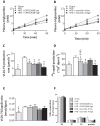GLP-1 receptor activation inhibits VLDL production and reverses hepatic steatosis by decreasing hepatic lipogenesis in high-fat-fed APOE*3-Leiden mice
- PMID: 23133675
- PMCID: PMC3487842
- DOI: 10.1371/journal.pone.0049152
GLP-1 receptor activation inhibits VLDL production and reverses hepatic steatosis by decreasing hepatic lipogenesis in high-fat-fed APOE*3-Leiden mice
Abstract
Objective: In addition to improve glucose intolerance, recent studies suggest that glucagon-like peptide-1 (GLP-1) receptor agonism also decreases triglyceride (TG) levels. The aim of this study was to evaluate the effect of GLP-1 receptor agonism on very-low-density lipoprotein (VLDL)-TG production and liver TG metabolism.
Experimental approach: The GLP-1 peptide analogues CNTO3649 and exendin-4 were continuously administered subcutaneously to high fat diet-fed APOE*3-Leiden transgenic mice. After 4 weeks, hepatic VLDL production, lipid content, and expression profiles of selected genes involved in lipid metabolism were determined.
Results: CNTO3649 and exendin-4 reduced fasting plasma glucose (up to -30% and -28% respectively) and insulin (-43% and -65% respectively). In addition, these agents reduced VLDL-TG production (-36% and -54% respectively) and VLDL-apoB production (-36% and -43% respectively), indicating reduced production of VLDL particles rather than reduced lipidation of apoB. Moreover, they markedly decreased hepatic content of TG (-39% and -55% respectively), cholesterol (-30% and -55% respectively), and phospholipids (-23% and -36% respectively), accompanied by down-regulation of expression of genes involved in hepatic lipogenesis (Srebp-1c, Fasn, Dgat1) and apoB synthesis (Apob).
Conclusion: GLP-1 receptor agonism reduces VLDL production and hepatic steatosis in addition to an improvement of glycemic control. These data suggest that GLP-receptor agonists could reduce hepatic steatosis and ameliorate dyslipidemia in patients with type 2 diabetes mellitus.
Conflict of interest statement
Figures




Similar articles
-
Exendin-4 decreases liver inflammation and atherosclerosis development simultaneously by reducing macrophage infiltration.Br J Pharmacol. 2014 Feb;171(3):723-34. doi: 10.1111/bph.12490. Br J Pharmacol. 2014. PMID: 24490861 Free PMC article.
-
GLP-1 Elicits an Intrinsic Gut-Liver Metabolic Signal to Ameliorate Diet-Induced VLDL Overproduction and Insulin Resistance.Arterioscler Thromb Vasc Biol. 2017 Dec;37(12):2252-2259. doi: 10.1161/ATVBAHA.117.310251. Epub 2017 Oct 26. Arterioscler Thromb Vasc Biol. 2017. PMID: 29074588
-
GLP-1 receptor agonism ameliorates hepatic VLDL overproduction and de novo lipogenesis in insulin resistance.Mol Metab. 2014 Sep 28;3(9):823-33. doi: 10.1016/j.molmet.2014.09.005. eCollection 2014 Dec. Mol Metab. 2014. PMID: 25506548 Free PMC article.
-
Effect of GLP-1 based therapies on diabetic dyslipidemia.Curr Diabetes Rev. 2014;10(4):238-50. doi: 10.2174/1573399810666140707092506. Curr Diabetes Rev. 2014. PMID: 24998439 Review.
-
New and emerging regulators of intestinal lipoprotein secretion.Atherosclerosis. 2014 Apr;233(2):608-615. doi: 10.1016/j.atherosclerosis.2013.12.047. Epub 2014 Jan 21. Atherosclerosis. 2014. PMID: 24534456 Review.
Cited by
-
The dipeptidyl peptidase-4 inhibitor sitagliptin protects against dyslipidemia-related kidney injury in Apolipoprotein E knockout mice.Int J Mol Sci. 2014 Jun 26;15(7):11416-34. doi: 10.3390/ijms150711416. Int J Mol Sci. 2014. PMID: 24972137 Free PMC article.
-
Brain Control of Plasma Cholesterol Involves Polysialic Acid Molecules in the Hypothalamus.Front Neurosci. 2017 May 3;11:245. doi: 10.3389/fnins.2017.00245. eCollection 2017. Front Neurosci. 2017. PMID: 28515677 Free PMC article.
-
Efficacy of photodynamic therapy using hematoporphyrin derivative nanomedicine on hepatocellular carcinoma cells.J Cancer. 2024 Sep 3;15(17):5594-5604. doi: 10.7150/jca.97637. eCollection 2024. J Cancer. 2024. PMID: 39308685 Free PMC article.
-
The Impact of Incretin-Based Medications on Lipid Metabolism.J Diabetes Res. 2021 Dec 29;2021:1815178. doi: 10.1155/2021/1815178. eCollection 2021. J Diabetes Res. 2021. PMID: 35005028 Free PMC article.
-
Bile acids and incretins as modulators of obesity-associated atherosclerosis.Front Cardiovasc Med. 2025 Jan 6;11:1510148. doi: 10.3389/fcvm.2024.1510148. eCollection 2024. Front Cardiovasc Med. 2025. PMID: 39834741 Free PMC article. Review.
References
-
- Stumvoll M, Goldstein BJ, van Haeften TW (2005) Type 2 diabetes: principles of pathogenesis and therapy. Lancet 365: 1333–1346. - PubMed
-
- Kahn SE, Hull RL, Utzschneider KM (2006) Mechanisms linking obesity to insulin resistance and type 2 diabetes. Nature 444: 840–846. - PubMed
-
- Lewis JR, Mohanty SR (2010) Nonalcoholic fatty liver disease: a review and update. Dig Dis Sci 55: 560–578. - PubMed
-
- Kreymann B, Williams G, Ghatei MA, Bloom SR (1987) Glucagon-like peptide-1 7–36: a physiological incretin in man. Lancet 2: 1300–1304. - PubMed
-
- Larsen PJ, Tang-Christensen M, Holst JJ, Orskov C (1997) Distribution of glucagon-like peptide-1 and other preproglucagon-derived peptides in the rat hypothalamus and brainstem. Neuroscience 77: 257–270. - PubMed
Publication types
MeSH terms
Substances
LinkOut - more resources
Full Text Sources
Molecular Biology Databases
Miscellaneous

